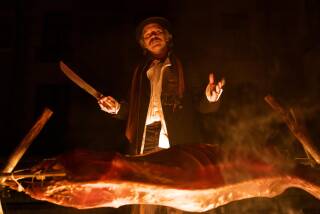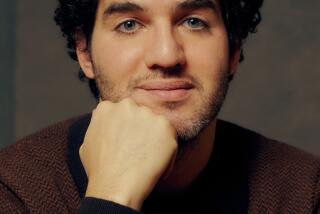MOVIE REVIEW : Two Young Friends Seek ‘The Cure’ in AIDS Drama
- Share via
“The Cure,” a well-acted heart-tugger about two 11-year-old boys, one of whom has AIDS, works as a drama on friendship and its challenges, but has too many loose ends, too much that hasn’t been thoroughly thought out. Where many films fall apart toward the finish, “The Cure” gets into gear at last but too late to redeem earlier flaws.
It opens with a vexing vagueness that undercuts all that follows. We don’t know where its charming small-town setting is supposed to be; the end credits tell us we’ve been in Stillwater, Minn. For reasons we never learn, a single mother, Linda (Annabella Sciorra) has just moved there with her son Dexter (Joseph Mazzello). Apparently, their next-door neighbors, a bitter divorcee Gail (Diana Scarwid) and her son Erik (Brad Renfro) are seemingly also fairly recent arrivals; we don’t know why Gail, a real estate broker, has picked out this obscure community either. We never learn what happened to Dexter’s father.
Apparently, Erik is sufficiently unhappy and new in town that he hasn’t made any friends. He bluntly tells Dexter across the fence that having a “faggot” for a neighbor is not going to help matters for him. When Dexter replies he got AIDS via a blood transfusion, Erik accepts him with a credibility-defying rapidity.
Shortly thereafter, the boys are beset by bullies, also slurring Erik. Erik stands up for Dexter but later admits that he doesn’t understand how he could associate with “homos” during his hospital stays. Intentionally or not, writer Robert Kuhn lets stand a distinction between straights and gays infected with the AIDS virus when he might better have suggested that all people with AIDS, regardless of sexual orientation, are worthy of compassion.
Dexter and Erik are exceptionally bright and articulate lads, as is usual for “sensitive” Hollywood films, so it is difficult to accept that they’d try to run away to New Orleans, where Erik’s father lives and where a man with a purported cure for AIDS also lives.
They’ve read about him in a supermarket tabloid and told Linda, who responds with tactful skepticism, suggesting that Dexter discuss the matter with his doctor. It’s therefore all the harder to believe they’d actually take off--especially with only $40 and a limited supply of medicine for Dexter.
Despite all these flaws, actor Peter Horton, in his feature directing debut, does elicit beautifully drawn and sustained portrayals from his young actors and also from Sciorra, whose mother--gallant, tough-minded, loving yet vulnerable--is perhaps the film’s most fully realized individual, even though we don’t know as much about her as we could.
As for Scarwid, this fine actress is stuck with yet another thankless role, this time as a nasty, ignorant wino. Bruce Davison appears briefly but effectively as Dexter’s staunch physician.
All told, “The Cure” plays more like a movie made for TV than the big screen.
* MPAA rating: PG-13, for emotional thematic elements, and for language. Times guidelines: Parental discretion is advised in regard to the film’s AIDS theme; the blunt language is neither inappropriate nor excessive.
(BEGIN TEXT OF INFOBOX / INFOGRAPHIC)
‘The Cure’ Joseph Mazzello: Dexter Brad Renfro: Erik Annabella Sciorra: Linda Diana Scarwid: Gail Bruce Davison: Dr. Stevens A Universal and Island Pictures presentation. Director Peter Horton. Producers Mark Burg, Eric Eisner. Executive producers Todd Baker, Bill Borden. Screenplay by Robert Kuhn. Cinematographer Andrew Dintenfass. Editor Anthony Sherin. Costumes Louise Frogley. Music Dave Grusin. Production designer Armin Ganz. Art director Troy Sizemore. Set decorator Claire Bowin. Running time: 1 hour, 35 minutes.
* In general release throughout Southern California.
More to Read
Only good movies
Get the Indie Focus newsletter, Mark Olsen's weekly guide to the world of cinema.
You may occasionally receive promotional content from the Los Angeles Times.










